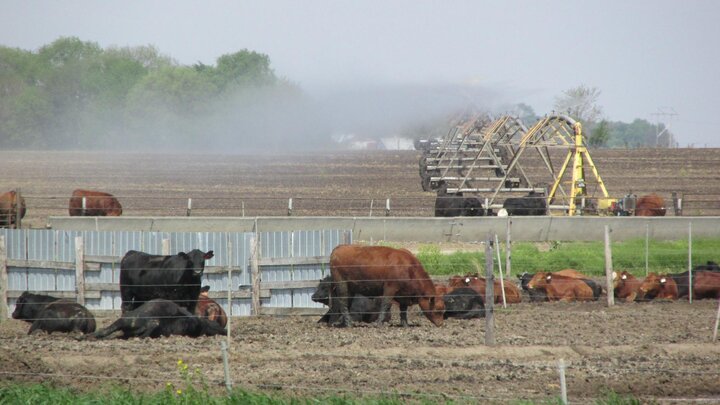Is Manure Irrigation Risky Business?
Have you ever wondered how far bacteria are carried in the air when applying manure through an irrigation system? Wonder no more. Because of a growing concern about manure irrigation, the University of Wisconsin Extension assembled a workgroup to research the concerns. The workgroup included scientists, public health specialists, state agency experts, farmers, conservationists and others. Over the course of two years, the group gathered and studied the science of manure irrigation, which culminated in a report that contains findings, responses and recommendations. This article will review a few of their findings related to bacterial transport as well as highlight some of the reasons why a farmer might opt to apply manure via irrigation rather than other ways.
What is manure irrigation?

Why do farmers apply manure to their crops?
Using manure as a fertilizer recycles nutrients. Crops are fed to animals to meet their nutritional needs. Any nutrients that are fed and not utilized by the animal are excreted in the manure. Thus, manure contains many nutrients that crops need, so it makes a very good fertilizer. It also has other benefits, including reduced erosion and runoff and aggregate stability in soils.
Why use irrigation over other methods?
| Manure Type | Applicator Options |
|---|---|
| Solid (>20% solids) |
Solid Spreader |
| Semi-solid (10-20% solids) | None. Material is too wet to handle as solid and too dry to handle as a slurry. |
| Slurry (5-10% solids) | Tanker spreader with or without an injection toolbar Side-slinger spreader Towed-hose applicator |
| Effluent ( | Tanker spreader with or without an injection toolbar Towed-hose applicator Traveling gun Center pivot (depending on particle size of solids) |
Farmers have multiple options when applying manure to their fields as shown in the table to the right. All options (excluding irrigation) require manned vehicles moving back and forth across the field, which may cause compaction and use more fuel compared to irrigation. Moving effluent from one place to another is expensive because it is very heavy for the amount of nutrients it contains. If tanker spreaders are used, the volume requires lots of trucks or many trips back and forth from the storage to the field, causing wear and tear on equipment as well as roads. In most cases where center pivot systems are used, the infrastructure needed to move the effluent from the manure storage to the pivot is already in place. In a situation where a traveling gun is to be used, temporary flexible hoses are used. In addition, in many situations, irrigating manure allows a farmer to apply manure during the growing season when other application methods cannot. Care should be taken to watch manure salt content (measured by electrical conductivity) when making applications during the growing season. This is particularly an issue in swine manure.
Bacterial transport through the air
In a study done by USDA-ARS in Wisconsin on dairy manure and shared through the Livestock and Poultry Environmental Learning Center Webinar Considerations for the use of Manure Irrigation Practices, it was found that distance from the application was the most significant factor when considering risk of infection from manure-borne pathogens being transported through air. Other factors that were significant were pathogen-type and how prevalent it is in the manure being irrigated; risk decreases when smaller amounts of the pathogen are found in the manure. Additionally, it is important to note that exposure to the sun inactivates pathogens while they are still in the air.
Regulations in Nebraska
In the state of Nebraska, manure irrigation regulations are the mostly the same as other methods of manure application to cropland, including recordkeeping, inspections and setbacks. In addition, irrigation systems that are connected to a water source must have devices installed (see title 130, chapter 10, section 004) to prevent manure from flowing back into the well. In addition, irrigation water must be sampled prior to manure application through the system and at least every 5 years thereafter to verify that manure has not been accidentally drawn into the well (see title 130, chapter 14, section 001.11D).
Summary
Reasons for choosing irrigation over other application methods vary, including timing of application, labor needed, or cost of transport, but for many farmers, irrigation is a great option for application of effluent to cropland. Risk of infection from manure-borne pathogens decreases as distance from the application area increases and as levels of pathogens are decreased in the manure. While there’s always a small chance that someone could get sick from a pathogen that they pick up following exposure to a manure application, that risk is very low in most cases.
This article was reviewed by Aaron Nygren and William Kranz